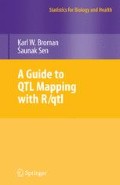It is often of interest to take account of a covariate (such as sex or an environmental factor, such as diet) in QTL mapping. If such a covariate has a large effect on the phenotype, its inclusion in the analysis will result in reduced residual variation and so will enhance our ability to detect QTL. It is also of interest to assess possible QTL × covariate interactions. For example, does a QTL have different effects in the two sexes?
Access this chapter
Tax calculation will be finalised at checkout
Purchases are for personal use only
Preview
Unable to display preview. Download preview PDF.
Author information
Authors and Affiliations
Corresponding author
Rights and permissions
Copyright information
© 2009 Springer-Verlag New York
About this chapter
Cite this chapter
Broman, K.W., Sen, Ś. (2009). Working with covariates. In: A Guide to QTL Mapping with R/qtl. Statistics for Biology and Health. Springer, New York, NY. https://doi.org/10.1007/978-0-387-92125-9_7
Download citation
DOI: https://doi.org/10.1007/978-0-387-92125-9_7
Published:
Publisher Name: Springer, New York, NY
Print ISBN: 978-0-387-92124-2
Online ISBN: 978-0-387-92125-9
eBook Packages: Biomedical and Life SciencesBiomedical and Life Sciences (R0)

